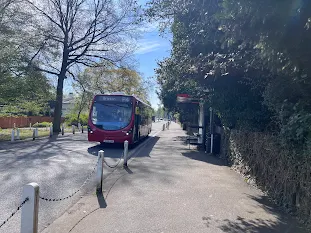Until someone had the idea to make the Blackwall and Silvertown tunnels toll roads, there was only one last remnant of the bygone tolling era in London. That road is College Road in Dulwich, and having walked down it recently, I can gladly say that the road is both modernising with the times, and that it's nothing all too peculiar, tollbooth aside. However, it does have its own railway station, and occasional bus connection, which is something many roads can't say they have.
It would be a lie to say that you can't enter College Road at all unless you paid the toll, though. There is only one tollbooth, after all, which means that if you want to drive through College Road, you'll have to pay, but for access either side of the booth, you're fine to not pay.
An obvious question is, why impose a toll here anyways? It's been imposed since 1787, in fact, from when the road was constructed by John Morgan, the Lord of the Manor of Penge, to link what was then Penge Common to Dulwich, and would allow anyone from the bordering Dulwich College to use it for free. The college has been here since 1619, and has since evolved into including a preschool, alongside the original private boys' boarding school. Dulwich College allowed Morgan to build the road so long as he imposed a width restriction and paid them annually for the road. As such, this London anachronism has persisted - until a few days ago, of course. Amusingly, some websites don't even consider College Road in their list of toll roads in London.
At its northern end, College Road is very ordinary. Here lies the Dulwich Picture Gallery, subject of a future blogpost. The P4 runs here, about halfway in its route from Brixton to Lewisham, and there is no tollbooth in sight. The college shortly comes into view, however, as we approach the South Circular, and the sign "PRIVATE ROAD" can now be seen as well.

A small lake with the occasional duck is hidden behind a fence on one side of the road - opposite is the college itself, in all its architectural splendour. Some were frolicking on the well-kempt fields, though it was a half-term (then again, this is a boarding school) outside the fine main building with its ornate Gothic clocktower. I'd never have a chance to get into those grounds, though; I was restricted to College Road, which by now also showed one indication that it was tolled - "Caution, Tollgate Ahead, £1.20".

Walking past the boarding houses - Blew House and Ivyholme - and the college's own running track and fields, along with a sign stating "no right of way or right of play", I finally got to the tollbooth itself, which is a rather small hut of sorts. There were roadworks just before the booth, but I doubt a 3-way operation was required here exactly since you had two private roads intersecting each other (Grange Lane is the other, and it goes down to a golf club). And I just so happened to turn up a week after they went cashless. The total cost of passing through is £1.20 for all vehicles at all time, albeit cyclists go free. Compare and contrast with the Blackwall and Silvertown tunnels, which have varying tiers depending on vehicle and peak times.
.HEIC)
After passing through, the road becomes quite mundane because the main point of interest is now past you. The youth section of Dulwich College, or DUCKS, is just ahead, centred in a far less glamorous building than the main college, and a series of large houses stand on either side of the road. Eventually, though, the wonderful Sydenham Hill Wood arrives to College Road, and about here, you get the aptly named Sydenham Hill station.

It's not the busiest station, with about 676,000 users annually, but it is quite lovely, surrounded by trees on all sides and which makes it feel quite secluded compared to other stations. Trains running towards Penge pass through a lengthy railway tunnel, albeit they're operated by Southeastern so the experience isn't as enjoyable as it otherwise could be. It's also unusual that its main entrance faces College Road, but at this point it's far from a private road nature.
The road soon merges with Kingswood Drive, and in theory the journey should stop here - but College Road still runs a bit further south from here. The 450 bus runs along here, albeit with no stops, and that's the last any public transport service will encounter College Road. From here it's a brief walk down to the main road, where it even becomes the southernmost tip of the A2199 before concluding by Crystal Palace, near the transmitting tower and park.
.HEIC)
For most of its existence, College Road isn't all too unique, but for a brief section, it's arguably the strangest in London. A symbol of the wealthy for a moment, its near 2 mile length is otherwise quite dull, what with its 20mph speed limit and benign landmarks. The trip is recommended on foot.
.HEIC)
👍🏻
ReplyDelete